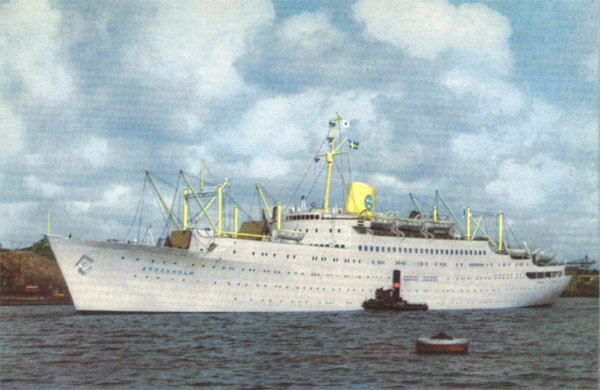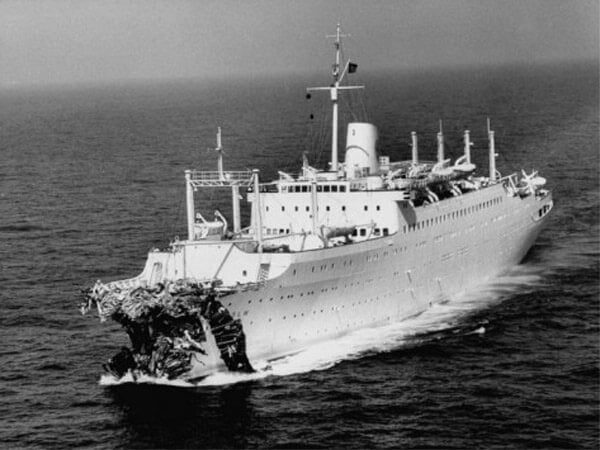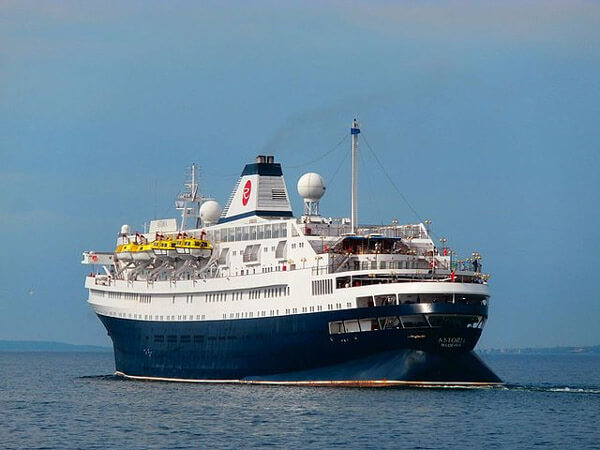Infamous Liner Turned Cruise Ship to Be Sold at Auction 77 Years After MV

One of the most historic passenger ships is facing an uncertain future that will likely end with the ship being removed for scrap after not having operated for the past five years. Today known as Astoria, the ship is best remembered as the Swedish liner Stockholm that was involved in the fatal collision with the Italian liner Andrea Doria in 1956.
The Rotterdam District Court has ordered the ship to be sold at auction on June 17. The proceeds of the sale will be used to pay her dockage fees in Rotterdam. She was moved to the Dutch port in December 2020 after having been laid up in the UK at the onset of the pandemic.
Previously, it was reported that she had been offered for sale and various rumors circled of efforts to save the ship which is one of the last ocean liners and the oldest ocean-going cruise ship. She was placed on the auction block in 2021 with a minimum bid of €10 million but failed to receive sufficient bids. In 2023, it was rumored that the ship had been sold for scrap, but the owners denied it saying they were still working on plans for her future.
The ship was ordered at the close of World War II as one of the first modern passenger liners. Limited by post-war shortages of materials and the capabilities of Scandinavian shipyards, Swedish American Line which had operated well-known luxury liners before the war, was limited to a 525-foot liner that at 11,700 gross tons would be a workhorse carrying cargo and mostly tourist class passengers. She was designed for year-round Atlantic service and sailing to Scandinavia she was given an ice-reinforced hull and bow which would forever seal her legacy.

1950s vintage post card view of the Stockholm
She entered service in February 1948 as Stockholm and was rebuilt in 1952 expanding her accommodations, but she had a mostly unremarkable career. Swedish American added a new modern liner in 1953 meaning Stockholm could also occasionally sail cruises.
Her legacy came however on the fateful night of July 25, 1956. Outbound from New York to Scandinavia, she was near the Nantucket Lightship when the Italian liner Andrea Doria emerged out of a fog bank making a turn across the course of the Stockholm. While the ships had radar available the technology was in its early stages of development, far less advanced than current systems. The ice-strengthened bow of the Stockholm tore through the Andrea Doria's starboard side causing a fatal wound. A massive sea rescue effort saved most of the passengers aboard the Italian ship, which sank the following morning, while the badly damaged Stockholm limped back to New York for repairs. A total of 51 passengers and crew on the two liners were killed in the tragedy.

Stockholm returned to New York badly damaged after her collision with the Italian liner Andrea Doria (USCG photo)
Swedish American rebuilt the ship but retired her four years later selling her to an East German group that used her as the Volkerfreundschaft for cruises for trade unionists and Community Party members. Retired by the Germans in 1985, she ended up in Italy where in a project reportedly heavily subsidized by the government she was rebuilt into a modern cruise ship. She was stripped to the steel and given a new diesel power plant as well as sponsons along the hull.
Mostly unrecognizable, she returned to service in 1994 and operates cruises for various companies under multiple names including Italia Prima, Valtur Prima, Caribe, and Athena. She was renamed Azores in 2013 by her latest owner/operator, and three years later was chartered to the UK’s Cruise & Maritime Voyages (CMV) who changed her name to Astoria. She continued to cruise building a loyal following because of her quirky history but CMV planned to retire her by 2020. The pandemic however brought her career to a premature close.
Unlike the vessels that were owned by CMV, Astoria was operating on charter so she reverted to her owners, which by that point was a Portuguese bank that had financed her last owners. An investment group acquired the Astoria but later abandoned plans to rebuild her due to advanced age. Since 2021, she has been listed for sale.
Due to her age, and reports that her interiors are in poor condition after years of being laid up, it is unlikely that she would be reactivated. She is to be sold to the highest bidder with the speculation that would be a cash buyer or a scrapyard.

Near the end of her career, although heavily rebuilt, the sheer of the liner hull is still visible (Pjotr Mahhonin photo - CC BY-SA 4.0)
Top photo by Niels Johannes - CC BY-SA 4.0
